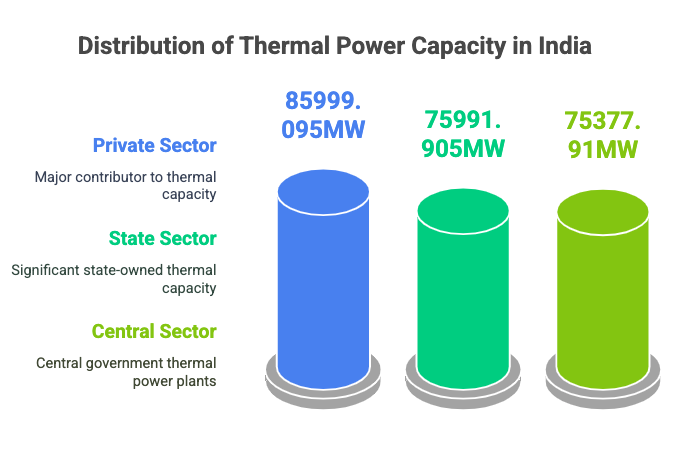18 February 2025 : The Hindu Editorial Analysis
1. Lighten the pollution burden of thermal power States
(Source – The Hindu, International Edition – Page No. – 8)
| Context |
|
India’s Climate Commitments and Energy Sector Overview
- India, under the Paris Agreement, aims to reduce GDP emissions intensity by 45% by 2030 and achieve 50% installed capacity from non-fossil fuel sources.
- Despite these goals, thermal power still dominates India’s electricity sector and is expected to retain a 50% share under the new regime.
- The total installed electricity capacity in India is 4,56,757 MW, with contributions from:
- Private sector: 53.4%
- State sector: 23.7%
- Central sector: 22.9%
Contribution of Thermal Power to India’s Electricity
- Thermal power capacity in India stands at 2,37,268.91 MW, distributed among:

- Coal accounts for 59.12% of India’s energy supply, with reserves of 378.21 billion tonnes, of which Odisha holds 94.52 billion tonnes.
- In 2022-23, 73.08% of electricity was generated from coal, oil, and natural gas.
- Thermal power is a major contributor to 20,794.36 kg of carbon emissions from electricity generation.
Producing States vs. Consuming States
- According to the Central Electricity Authority (CEA) Maharashtra has the highest non-renewable electricity generation capacity (31,510.08 MW), followed by Uttar Pradesh and Gujarat.
- Rajasthan leads in renewable electricity generation with 22,398.05 MW.
- States producing the most electricity do not necessarily consume most of it. For example:
- Uttar Pradesh consumes only 40% of its NTPC-produced electricity.
- Odisha consumes 38.43% of its NTPC-generated power.
- Chhattisgarh uses only 29.92% of what it generates.
- Gujarat is the biggest consumer of NTPC-produced electricity (4,612 MW) despite generating only 17.7 MW itself.
Disproportionate Pollution Burden on Producing States
- States with the highest thermal power share include:
- Tripura (96.96%), Bihar (95.57%), Chhattisgarh (94.35%), Jharkhand (92.69%), Delhi (87.96%), and West Bengal (87.72%).
- These States produce large amounts of electricity but do not consume all of it.
Electricity Trade Between States
- Chhattisgarh is the highest net seller (535.29 MW), followed by Madhya Pradesh and Himachal Pradesh.
- Gujarat is the largest importer of electricity (528.17 MW), followed by Haryana, Maharashtra, and Delhi.
- While some States benefit from buying electricity, others suffer from pollution caused by thermal power production.
Lack of Compensation for Producing States
- India’s laws do not provide compensation to States that generate electricity for others.
- Coal-rich States such as Jharkhand, Chhattisgarh, and Odisha produce maximum thermal electricity but have lower per capita electricity consumption.
- Electricity is a Concurrent subject under the Constitution, meaning both central and State governments can legislate on it.
- However, States cannot tax electricity generation, while consuming States benefit from taxes on electricity sales.
Potential Compensation Mechanisms
- Taxing Thermal Power Generation
- Producing States could be allowed to levy a tax on electricity generation.
- Alternatively, the Union government could collect and distribute such a tax to producing States.
- Compensation through the Finance Commission
- The Finance Commission has previously recommended environmental grants and devolution of funds.
- The upcoming Sixteenth Finance Commission should design a fiscal roadmap to support thermal power-producing States.
Conclusion
- By implementing these measures, electricity-producing States can be fairly compensated for the pollution burden they bear while supplying power to others.
| PYQ: Mumbai, Delhi and Kolkata are the three megacities of the country but the air pollution is a much more serious problem in Delhi as compared to the other two. Why is this so? (200 words/12.5m) (UPSC CSE (M) GS-1 2015) |
| Practice Question: Discuss the environmental and fiscal challenges faced by thermal power-producing States in India. Suggest measures to ensure equitable compensation for pollution burdens. (150 Words /10 marks) |
2. Georgia and the resurrection of the colour revolutions
(Source – The Hindu, International Edition – Page No. – 8)
| Context |
|
Background of Colour Revolutions
- With the beginning of the 21st century, several post-Soviet States witnessed peaceful uprisings known as the “colour revolutions.”
- These movements aimed to replace pro-Moscow governments with pro-Western administrations under the banner of democratic reforms.
- Though largely non-violent, Russia perceived them as Western-backed strategies to weaken its influence.
| Key Colour Revolutions |
|
Russia’s Perspective on Colour Revolutions
- Russia viewed these movements as efforts to destabilize its influence in neighbouring States.
- The strategy aligned with Western policies of political subversion rather than direct confrontation.
- Russia and other nations, such as China, saw these revolutions as models for foreign interventions in regions like West Asia, Africa, and South Asia.
Failures of the Colour Revolutions
- Despite promises of democratic transformation, these revolutions often led to corruption and governance failures.
- The new governments were accused of serving Western interests rather than prioritizing domestic development.
- Public frustration and disillusionment grew as promised reforms failed to materialize.
Georgia’s Political Turmoil
- The Rose Revolution initially established a pro-Western government. However, corruption and authoritarianism soon became prevalent.
- A similar situation is unfolding again, with recent elections sparking protests over alleged electoral malpractices.
- The ruling party claims that Western-backed NGOs are influencing internal affairs, highlighting concerns of external interference.
Geopolitical Struggles in Georgia
- Georgia is strategically located between Europe and Asia, making it a focal point in global power struggles.
- Russia, despite setbacks from the Ukraine conflict, continues to assert its influence in the region.
- The U.S. faces challenges in engaging actively due to internal political changes and shifting global priorities.
Future of Colour Revolutions
- The effectiveness of soft power strategies like democracy promotion is declining.
- Georgia’s political situation reflects the broader challenges faced by post-Soviet States navigating global power conflicts.
- Whether the colour revolution model remains relevant depends on evolving international relations and the ability of these States to balance external pressures.
| Practice Question: What do you understand by Colour Revolutions? How have these movements influenced regional stability and global geopolitical dynamics? (150 Words /10 marks) |



